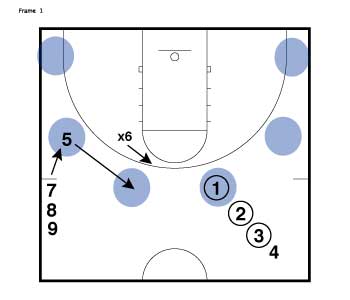We often hear (from coaches that don't know the offense very well) that the Read & React doesn't promote screening. And, that couldn't be further from the truth - you just have to emphasize it. Here are 4 steps that will train your players to spot some of the screening opportunities within the flow of the offense.
Step 1: Start with the basics.
If you have a post player, try this simple 5 on 0 drill. Place 4 players on the perimeter running though Pass & Cut. Tell your post player to screen for cutters coming into the lane and leaving the lane. And, just like the Post Screening layer says, have the post player set a screen, then shape up for the ball. Set a screen, then shape. Screen, then shape. The only way to score in this drill is to hit a cutter (following a screen) for a lay-up or to feed the post on the shape up. After the score, just rotate the post - it wouldn't be a bad idea to rotate guards through the post as well.
If you typically run a 5 OUT, start with 5 players on the perimeter running through Pass & Cut. At random each player must stop in the post, set some screens for cutters, then shape up after a screen. Following the shape up, they can vacate the post and return to the perimeter. In this version of the drill, the only way to score is a post feed to a shaping up post player. After the score, simply grab the rebound, pass it back to the perimeter and continue the drill until every player has stopped in the post, set screens for cutters, shaped up, and scored.
With those drills, you get to work on Layer 1, feeding the post, scoring in the post, setting screens, and using screens.
Step 2: Building on the basics.



